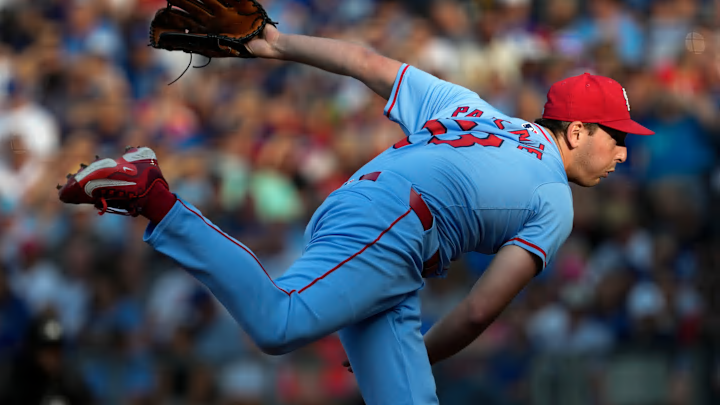The St. Louis Cardinals' pipeline is amazing at producing two types of players: utility players who are slightly above-average hitters and groundball pitchers.
We've seen position players like Matt Carpenter, Tommy Edman, Brendan Donovan, and Paul DeJong come through the system and have success. Also, pitchers like Jaime Garcia, Dakota Hudson, who was recently released by the Colorado Rockies, and Seth Maness were experts at generating groundballs.
The latest in a long line of groundball pitchers is right-handed starter Andre Pallante. Pallante's profile leans heavily toward generating soft contact on the ground. Among pitchers who have thrown at least 100 innings for the Cardinals since 2012, Pallante ranks #1 overall in groundball rate (67.2%) by a hefty margin -- Jordan Hicks is second at 60.6%.
Pallante's propensity to force hitters to hit groundballs has brought up a lot of comparisons to a player on the list above: Dakota Hudson. During his time in St. Louis, Dakota Hudson had a 55.1% groundball rate. That's well above league average, so it's logical to conflate Pallante with Hudson.
However, there are many differences between the two starting pitchers. While they both generate groundballs at high rates, Pallante has excelled at limiting hard contact. He has allowed soft contact on 19.6% of balls in play, 6th for the Cardinals since 2012. His 3.7% barrel rate against this year is in the 95th percentile in baseball. Hudson, on the other hand, allowed hard contact on 34.7% of balls in play while Pallante has allowed hard contact just 26.3% of the time.
The two pitchers also differ greatly in strikeout and walk rate. Pallante has a career 18.3% K rate while Hudson had a 15.8% K rate. Pallante has also walked batters at a 8.2% rate compared to Hudson's 10.5% rate. Pallante has struck out an average amount of hitters while limiting walks. Hudson has done the opposite.
The final stat that shows the differences between Andre Pallante and Dakota Hudson would be FIP, or fielding independent pitching. This statistic shows how effective a pitcher is by focusing on events they have more control over, such as walks, strikeouts, and home runs. Dakota Hudson's FIP during his time in St. Louis was 4.72. Pallante's? 3.87.
Pallante's FIP and ERA are nearly identical, so he's not benefitting from extraordinary defense or luck. Instead, he's throwing the ball in a way that forces hitters to play into the defense. Hudson, on the other hand, experienced a bit of luck when comparing his ERA to his FIP.
On the surface, Andre Pallante and Dakota Hudson have similar profiles, but a closer look at these starters shows clear differences between the two groundball-heavy pitchers.
